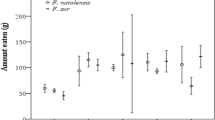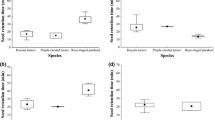Abstract
Invasive alien plants can use animal-plant interactions to increase their invasiveness. This study investigated the role of frugivorous birds in seed dispersal, germination success and germination time of the alien plant Pyracantha angustifolia (Franch.) C.K. Schneid. (Rosaceae) in South African high elevation grasslands. We monitored which bird species fed on the fruit of the invasive P. angustifolia in farms in the Free State Province using timed-focal and opportunistic observations, and camera traps aimed at fruiting branches and fallen fruits on the ground. Nine bird species visited P. angustifolia shrubs to perch or feed on fruits, but only one (Speckled Mousebird) fed on the fruits during timed-focal observations. Camera trap footage and opportunistic observations revealed a further three bird species (African Pied Starlings, Crested Barbets, Red-eyed Barbets), domestic horses and goats, and two rodent species feeding on fruits. To assess the effect of ingestion by avian frugivores on P. angustifolia germination success and time, P. angustifolia fruits were fed to captive Cape White-eyes (Zosterops virens), Dark-capped Bulbuls (Pycnonotus tricolor), Purple-crested Turacos (Gallirex porphyreolophus), Red-winged Starlings (Onychognathus morio) and Speckled Mousebirds (Colius striatus); frugivores present in the invasive range of P. angustifolia in South Africa. Seeds collected from bird excreta, whole fruits, and depulped fruits were grown under greenhouse conditions and germination times recorded. All captive bird species, except for Cape White-eyes, ingested the seeds; Cape White-eyes fed on fruit pulp only. Bird species with relatively larger body mass had longer seed retention times compared with the smaller bird species. Germination success of both depulped and ingested P. angustifolia seeds was significantly higher (> 80%) than for seeds from whole fruits (7%). Ingestion by the four avian frugivore species did not affect germination time and success; instead, the birds facilitate the spread and germination of seeds by removing the fruit pulp and spreading the seed away from the parent shrubs.



Similar content being viewed by others
Data availability
The data sets analysed during the study will be available in Zenodo repository [https://doi.org/10.5281/zenodo.4534703].
References
Castro SA, Saavedra D, Gutiérrez-Tapia P, Vergara PM (2016) The austral thrush (Turdus falcklandii) reduces the seed germination for the urban ornamental tree glossy privet (Ligustrum lucidum) in Santiago, Chile. Braz J Bot 39:949–952. https://doi.org/10.1007/s40415-016-0286-7
Charalambidou I, Santamaria L, Langevoord O (2003) Effect of ingestion by five avian dispersers on the retention time, retrieval and germination of Ruppia maritima seeds. Funct Ecol 17(6):747–753. https://doi.org/10.1111/j.1365-2435.2003.00787.x
Chari LD, Martin GD, Steenhuisen SL, Adams LD, Clark VR (2020) Biology of invasive plants 1. Pyracantha angustifolia (Franch.) CK Schneid. Invasive Plant Sci Manag 13(3):120–142. https://doi.org/10.1017/inp.2020.24
Cimi PV, Campbell EE (2017) Investigation of the plant species diversity, density, abundance and distribution in Grahamstown, South Africa. J Res For Wildl Environ 9:28–35
Csurhes S, Weber J, Zhou Y (2016) Invasive plant risk assessment: Firethorn Pyracantha Species. Queensland, Australia: Department of Agriculture and Fisheries Biosecurity
Cuizhi G, Spongengberg SA (2003) Pyracantha. In: Flora of China, vol 3, pp 108–111
D’Agostino RB, Belanger A, D’Agostino RB (1990) A suggestion for using powerful and informative tests of normality. Am Stat 44:16–321. https://doi.org/10.1080/00031305.1990.10475751
Daehler CC (1998) The taxonomic distribution of invasive angiosperm plants: ecological insights and comparison to agricultural weeds. Biol Cons 84:167–180. https://doi.org/10.1016/S0006-3207(97)00096-7
Dellafiore CM, Rosa MJ, Scilingo V (2019) Do birds affect the germination of the Pyracantha atalantoides shrub (Rosaceae)? SciELO 7:1–6
Díaz Vélez MC, Sérsic AN, Traveset A, Paiaro V (2018) The role of frugivorous birds in fruit removal and seed germination of the invasive alien Cotoneaster franchetii in central Argentina. Austral Ecol 43:558–566. https://doi.org/10.1111/aec.12592
Dlamini P, Zachariades C, Downs CT (2018) The effect of frugivorous birds on seed dispersal and germination of the invasive Brazilian pepper tree (Schinus terebinthifolius) and Indian laurel (Litsea glutinosa). S Afr J Bot 114:61–68. https://doi.org/10.1016/j.sajb.2017.10.009
Fricke EC, Bender J, Rehm EM, Rogers HS (2019) Functional outcomes of mutualistic network interactions: a community-scale study of frugivore gut passage on germination. J Ecol 107:757–767. https://doi.org/10.1111/1365-2745.13108
Giantomasi A, Tecco PA, Funes G, Gurvich DE, Cabido M (2008) Canopy effects of the invasive shrub Pyracantha angustifolia on seed bank composition, richness and density in a montane shrubland (Córdoba, Argentina). Austral Ecol 33:68–77. https://doi.org/10.1111/j.1442-9993.2007.01791.x
Hockey PAR, Dean WRJ, Ryan PG (2005) Roberts’ birds of southern Africa. John Voelcker Bird Book Fund, Cape Town
Holmes PM (1989) Decay rates in buried alien Acacia seed populations of different density. S Afr J Bot 55:299–303. https://doi.org/10.1016/S0254-6299(16)31179-6
Holmes PM (1990) Dispersal and predation in alien Acacia. Oecologia 83:288–290
Howe H (1989) Scatter- and clump- dispersal and seedling demography: hypothesis and implications. Oecologia 79:417–426
Janzen DH (1971) Seed predation by animals. Annu Rev Ecol Syst 2:465–492
Jordaan LA, Johnson SD, Downs CT (2011) The role of avian frugivores in germination of seeds of fleshy-fruited invasive alien plants. Biol Invasions 13:1917–1930. https://doi.org/10.1007/s10530-011-0013-z
Lafleur N, Rubega M, Parent J (2009) Does frugivory by European starlings (Sturnus vulgaris) facilitate germination in invasive plants? J Torrey Bot Soc 136:332–341. https://doi.org/10.3159/08-RA-111.1
Moffett R (2018) A field guide to the clarens village conservancy. African Sun MeDIA
Mokotjomela TM, Downs CT, Esler K, Knight J (2016) Seed dispersal effectiveness: A comparison of four bird species feeding on seeds of invasive Acacia cyclops in South Africa. S Afr J Bot 105:259–263. https://doi.org/10.1016/j.sajb.2016.04.005
Mora JP, Smith-Ramirez C (2016) Are birds, wind and gravity legitimate dispersers of fleshy-fruited invasive plants on Robinson Crusoe Island, Chile? Flora 224:167–171. https://doi.org/10.1016/j.flora.2016.07.012
Motulsky H (1999) Analyzing data with GraphPad prism. GraphPad Software Incorporated
Mucina L, Rutherford MC (2006) The vegetation of South Africa, Lesotho and Swaziland., South African Biodiversity Institute. Pretoria
Newman K, Newman V (2010). Newman’s birds of southern Africa (Commemorative Edition). Penguin Random House, South Africa
Richardson DM, Foxcroft LC, Latombe G, Le Maitre DC, Rouget M, Wilson JR (2020) The biogeography of South African terrestrial plant invasions. In: Van Wilgen BW, Measey J, Richardson DM, Wilson JR, Zengeya TA (eds) Biological invasions in South Africa. Springer, Cham, pp 67–96
South African Department of Environmental Affairs (2014) National Environmental Management: Biodiversity Act (10/2004): Alien and Invasive Species Regulations, 2014. Pretoria, South Africa: Government Gazette
Tabassum S, Leishman MR (2018) Have your cake and eat it too: greater dispersal ability and faster germination towards range edges of an invasive plant species in eastern Australia. Biol Invasions 20:1199–1210. https://doi.org/10.1007/s10530-017-1620-0
Tecco PA, Pais-Bosch AI, Funes G, Marcora PI, Zeballos SR, Cabido M, Urcelay C (2016) Mountain invasions on the way: are there climatic constraints for the expansion of alien woody species along an elevation gradient in Argentina? J Plant Ecol 9(4):380–392. https://doi.org/10.1093/jpe/rtv064
Thabethe V, Wilson AL, Hart LA, Downs CT (2015) Ingestion by an invasive parakeet species reduces germination success of invasive alien plants relative to ingestion by indigenous turaco species in South Africa. Biol Invasions 17:3029–3039. https://doi.org/10.1007/s10530-015-0932-1
Thibault M, Masse F, Pujapujane A, Lannuzel G, Bordez L, Potter MA, Fogliani B, Vidal É, Brescia F (2018) “Liaisons dangereuses”: the invasive red-vented bulbul (Pycnonotus cafer), a disperser of exotic plant species in New Caledonia. Ecol Evol 8:9259–9269. https://doi.org/10.1002/ece3.4140
Tiebel K, Huth F, Wagner S (2018) Soil seed banks of pioneer tree species in European temperate forests: a review. For Biogeosci For 11:48–57
Traveset A (1998) Effect of seed passage through vertebrate frugivores’ guts on germination: a review. Perspect Plant Ecol Evol Syst 1:151–190. https://doi.org/10.1078/1433-8319-00057
Valido A, Nogales M (1994) Frugivory and seed dispersal by the lizard Gallotia galloti (Lacertidae) in a xeric habitat of the Canary islands. Oikos 70:403–411
Vergara-Tabares DL, Toledo M, García E, Peluc SI (2018) Aliens will provide: avian responses to a new temporal resource offered by ornithocorous exotic shrubs. Oecologia 188:173–182
Wang BC, Smith TB (2002) Closing the dispersal loop. Trends Ecol Evol 17:379–385
Wells MJ, Balsinhas AA, Joffe H, Engelbrecht VM, Harding G, Stirton CH (1986) A catalogue of problem plants in southern Africa incorporating the national weed list of southern Africa. Botanical Survey of South Africa, Memoir no. 53
Wotton DM, Clout MN, Kelly D (2008) Seed retention times in the New Zealand pigeon (Hemiphaga novaezeelandiae novaeseelandiae). N Z J Ecol 32:1–6
Wróbel A, Zwolak R (2017) Deciphering the effects of disperser assemblages and seed mass on patterns of seed dispersal in a rodent community. Integr Zool 12:457–467
Zoeller KC, Steenhuisen S-L, Johnson SD, Midgley JJ (2016) New evidence for mammal pollination of Protea species (Proteaceae) based on remote-camera analysis. Aust J Bot 64:1–7
Acknowledgements
The Afromontane Research Unit, University of the Free State, supported Lehlohonolo Adams and Sandy-Lynn Steenhuisen with a Masters bursary and running costs for this project, respectively. The South African Department of Forestry, Fisheries and the Environment (DFFE) are thanked for funding, noting that this publication does not necessarily represent the views or opinions of DFFE or its employees. The South African Research Chairs Initiative of the Department of Science and Technology and the National Research Foundation of South Africa provided additional funding. Additional running costs provided by DSI-NRF Centre of Excellence for Invasion Biology (CIB) are acknowledged. Any opinion, finding, conclusion or recommendation expressed in this material is that of the authors, and the National Research Foundation does not accept any liability in this regard. Albert Malefane, Nicholas Le Maitre, Anthony Mapaura, and Lindokuhle Mdakane are thanked for assisting with field observational data collection. We are grateful to Sellwane Moloi for assistance with data analyses.
Author information
Authors and Affiliations
Contributions
LDA, GDM and SS conceived the study; LDA, VT and IAR collected the data; LDA analysed the data. All the authors participated in the writing of the manuscript and LDA, GDM, SS and VRC contributed substantially to revisions.
Corresponding author
Ethics declarations
Conflict of interest
The authors declare that they have no conflict of interest.
Additional information
Publisher's Note
Springer Nature remains neutral with regard to jurisdictional claims in published maps and institutional affiliations.
Supplementary Information
Below is the link to the electronic supplementary material.
Rights and permissions
About this article
Cite this article
Adams, L.D., Martin, G.D., Downs, C.T. et al. Seed dispersal by frugivores and germination of the invasive alien shrub Pyracantha angustifolia (Franch.) C.K. Schneid. in Free State Province, South Africa. Biol Invasions 24, 2809–2819 (2022). https://doi.org/10.1007/s10530-022-02807-5
Received:
Accepted:
Published:
Issue Date:
DOI: https://doi.org/10.1007/s10530-022-02807-5




